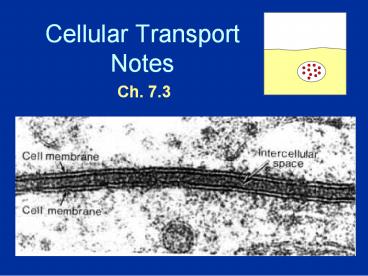Cellular Transport Notes PowerPoint PPT Presentation
Title: Cellular Transport Notes
1
Cellular Transport Notes
- Ch. 7.3
2
About Cell Membranes
- All cells have a cell membrane
- Functions
- Controls what enters and exits the cell to
maintain an internal balance called homeostasis - Provides protection and support for the cell
TEM picture of a real cell membrane.
3
About Cell Membranes (continued)
- Structure of cell membrane
- Lipid Bilayer -2 layers of phospholipids
- Phosphate head is polar (water loving)
- Fatty acid tails non-polar (water fearing)
- Proteins embedded in membrane
Phospholipid
Lipid Bilayer
4
Fluid Mosaic Model of the cell membrane
Polar heads love water dissolve.
Membrane movement animation
Non-polar tails hide from water.
Carbohydrate cell markers
Proteins
5
About Cell Membranes (continued)
- 4. Cell membranes have pores (holes) in it
- Selectively permeable Allows some molecules in
and keeps other molecules out - The structure helps it be selective!
Pores
6
Structure of the Cell Membrane
Outside of cell
Carbohydrate chains
Proteins
Lipid Bilayer
Transport Protein
Phospholipids
Inside of cell (cytoplasm)
Go to Section
7
Types of Cellular Transport
- Passive Transport
- cell doesnt use energy
- Diffusion
- Facilitated Diffusion
- Osmosis
- Active Transport
- cell does use energy
- Protein Pumps
- Endocytosis
- Exocytosis
8
Passive Transport
- cell uses no energy
- molecules move randomly
- Molecules spread out from an area of high
concentration to an area of low concentration. - (High?Low)
- Three types
9
3 Types of Passive Transport
- Diffusion
- Facilitative Diffusion diffusion with the help
of transport proteins - Osmosis diffusion of water
10
Passive Transport 1. Diffusion
Simple Diffusion Animation
- Diffusion random movement of particles from an
area of high concentration to an area of low
concentration. - (High to Low)
- Diffusion continues until all molecules are
evenly spaced (equilibrium is reached)-Note
molecules will still move around but stay spread
out.
http//bio.winona.edu/berg/Free.htm
11
Passive Transport 2. Facilitated Diffusion
A
B
- 2. Facilitated diffusion diffusion of specific
particles through transport proteins found in the
membrane - Transport Proteins are specific they select
only certain molecules to cross the membrane - Transports larger or charged molecules
Facilitated diffusion (Channel Protein)
Diffusion (Lipid Bilayer)
Carrier Protein
- http//bio.winona.edu/berg/Free.htm
12
Passive Transport 2. Facilitated Diffusion
Glucose molecules
Cellular Transport From a-
High
High Concentration
- Channel Proteins animations
Cell Membrane
Protein channel
Low Concentration
Low
Transport Protein
Through a ?
Go to Section
13
Osmosis animation
Passive Transport 3. Osmosis
- 3.Osmosis diffusion of water through a
selectively permeable membrane - Water moves from high to low concentrations
- Water moves freely through pores.
- Solute (green) to large to move across.
14
Active Transport
- cell uses energy
- actively moves molecules to where they are needed
- Movement from an area of low concentration to an
area of high concentration - (Low ? High)
- Three Types
15
Types of Active Transport
Sodium Potassium Pumps (Active Transport using
proteins)
- 1. Protein Pumps -transport proteins that require
energy to do work - Example Sodium / Potassium Pumps are important
in nerve responses.
Protein changes shape to move molecules this
requires energy!
16
Types of Active Transport
- 2. Endocytosis taking bulky material into a
cell - Uses energy
- Cell membrane in-folds around food particle
- cell eating
- forms food vacuole digests food
- This is how white blood cells eat bacteria!
17
Types of Active Transport
- 3. Exocytosis Forces material out of cell in
bulk - membrane surrounding the material fuses with cell
membrane - Cell changes shape requires energy
- EX Hormones or wastes released from cell
Endocytosis Exocytosis animations
18
Effects of Osmosis on Life
- Osmosis- diffusion of water through a selectively
permeable membrane - Water is so small and there is so much of it the
cell cant control its movement through the cell
membrane.
19
Hypotonic Solution
- Osmosis Animations for isotonic, hypertonic, and
hypotonic solutions
Hypotonic The solution has a lower
concentration of solutes and a higher
concentration of water than inside the cell. (Low
solute High water)
Result Water moves from the solution to inside
the cell) Cell Swells and bursts open
(cytolysis)!
20
Hypertonic Solution
- Osmosis Animations for isotonic, hypertonic, and
hypotonic solutions
Hypertonic The solution has a higher
concentration of solutes and a lower
concentration of water than inside the cell.
(High solute Low water)
shrinks
Result Water moves from inside the cell into
the solution Cell shrinks (Plasmolysis)!
21
Isotonic Solution
- Osmosis Animations for isotonic, hypertonic, and
hypotonic solutions
Isotonic The concentration of solutes in the
solution is equal to the concentration of solutes
inside the cell.
Result Water moves equally in both directions
and the cell remains same size! (Dynamic
Equilibrium)
22
What type of solution are these cells in?
C
B
A
Hypertonic
Isotonic
Hypotonic
23
How Organisms Deal with Osmotic Pressure
- Paramecium (protist) removing excess water video
- Bacteria and plants have cell walls that prevent
them from over-expanding. In plants the pressure
exerted on the cell wall is called tugor
pressure. - A protist like paramecium has contractile
vacuoles that collect water flowing in and pump
it out to prevent them from over-expanding. - Salt water fish pump salt out of their
specialized gills so they do not dehydrate. - Animal cells are bathed in blood. Kidneys keep
the blood isotonic by remove excess salt and
water.
24
This powerpoint was kindly donated to
www.worldofteaching.com http//www.worldofteac
hing.com is home to over a thousand powerpoints
submitted by teachers. This is a completely free
site and requires no registration. Please visit
and I hope it will help in your teaching.

